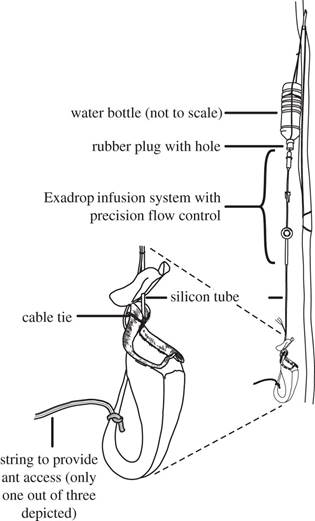

能设陷阱诱捕昆虫的猪笼草并非总是捕捉被吸引过来的蚂蚁和其他猎物。这种植物分布于东南亚地区的部分热带低地和马来群岛。当气候条件湿润时,这种多葡萄藤植物的一些罐状囊的边缘会十分平滑,因此,在上面行走的昆虫很容易滑进这些容器中充满能消化猎物的酶的液体中。
但在一天中最热的几个小时里,这些小罐的边缘变得干燥,这就让觅食的蚂蚁能够收集小罐里的花蜜,然后返回蚁群,并告知同伴这种植物物藏丰厚以及它的位置。在野外实验中,研究人员使用稀释的糖水不断地湿润着一些小罐的边缘,其他一些则保持原样。
总体而言,那些保持原样的小罐比总是湿润的多捕获了超过36%的蚂蚁,研究人员近日将相关结论在线发表于英国《皇家学会学报B》。科学家表示,这些发现首次支持了一个存在数十年的理论,猪笼草小罐间歇平滑的边缘,能通过让侦察兵蚂蚁安全逃离并诱使蚁群更多同伴到来,从而捕获更多蚂蚁。(来源:中国科学报 张章)
How to catch more prey with less effective traps: explaining the evolution of temporarily inactive traps in carnivorous pitcher plants
Abstract Carnivorous Nepenthes pitcher plants capture arthropods with specialized slippery surfaces. The key trapping surface, the pitcher rim (peristome), is highly slippery when wetted by rain, nectar or condensation, but not when dry. As natural selection should favour adaptations that maximize prey intake, the evolution of temporarily inactive traps seems paradoxical. Here, we show that intermittent trap deactivation promotes ‘batch captures' of ants. Prey surveys revealed that N. rafflesiana pitchers sporadically capture large numbers of ants from the same species. Continuous experimental wetting of the peristome increased the number of non-recruiting prey, but decreased the number of captured ants and shifted their trapping mode from batch to individual capture events. Ant recruitment was also lower to continuously wetted pitchers. Our experimental data fit a simple model that predicts that intermittent, wetness-based trap activation should allow safe access for ‘scout’ ants under dry conditions, thereby promoting recruitment and ultimately higher prey numbers. The peristome trapping mechanism may therefore represent an adaptation for capturing ants. The relatively rare batch capture events may particularly benefit larger plants with many pitchers. This explains why young plants of many Nepenthes species additionally employ wetness-independent, waxy trapping surfaces.
原文链接:http://rspb.royalsocietypublishing.org/content/royprsb/282/1801/20142675.full.pdf



